Metal and metal oxide amorphous nanomaterials towards electrochemical applications
Abstract
Amorphous nanomaterials have aroused extensive interest due to their unique properties. Their performance is highly related with their distinct atomic arrangements, which have no long-range order but possess short- to medium-range order. Herein, an overview of state-of-the-art synthesis methods of amorphous nanomaterials, structural characteristics and their electrochemical properties is presented. Advanced characterization methods for analyzing and proving the local order of amorphous structures, such as X-ray absorption fine structure spectroscopy, atomic electron tomography and nanobeam electron diffraction, are introduced. Various synthesis strategies for amorphous nanomaterials are covered, especially the salt-assisted metal organic decomposition method to prepare ultrathin amorphous nanosheets. Furthermore, the design and structure–activity relationship of amorphous nanomaterials towards electrochemical applications, including electrocatalysts and battery anode/cathode materials, is discussed.

- This article is part of the themed collection: 10th Anniversary of the Youth Innovation Promotion Association of the Chinese Academy of Science


 Please wait while we load your content...
Please wait while we load your content...